American Sabbatical 003: 8/30-9/1/96
Adirondacks
(Memo#2)
|
August 31 - Adirondacks
Thoughts about museums: What is or should be saved in a museum
? What is the purpose of museums? What would our students like
to save? Are museums really for kids? Did you / do you enjoy museums?
Why? What would make them more enjoyable? Does it make sense to
put objects behind glass?? Can you and a class create a specific
museum? Can we / should we start a retail boom museum for Freeport? |
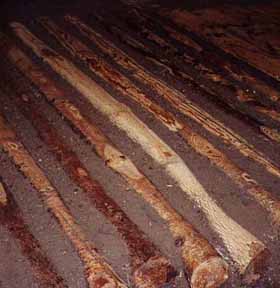
Corduroy Road
|
We are at a gorgeous camp on Goodnow Flowage, a small lake in
the center of the Adirondacks created by one of the lumber companies
as a place to store “yarded” wood. When that was no longer necessary,
house lots were sold off. There are some 250 houses around this
lake, but it’s quiet and low key. A totally artificial community
with by-laws, it’s an association. They have rules like no motors
of more than 10 hp. A super chance to relax.
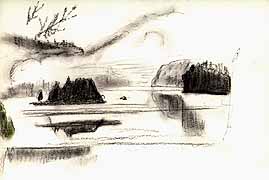
Goodnow Fog (Peggy)
|
Our hosts said we had to go to the Adirondacks Museum, and I’m
so glad we did. It’s about 45 minutes away, a series of building
on a hillside overlooking Blue Lake. Many individual buildings
constructed for a specific purpose (to show a railroad car), or
period buildings brought to the sight. On the way we talked about
what history is preserved and what isn’t. I specifically mentioned
roads as an “artifact” that was difficult to preserve -- we got
to the museum and one of the special exhibits was on roads in
the Adirondacks. It even had examples of a corduroy road !!! |
Great exhibit on tuberculosis and the cure spas in the Adirondacks.
Great text, diaries of TB patients, ads for cures. There was a
place where four TB patients were described and then you were
given three choices of treatment. They had super medical exhibits
- an Xray of a healthy and a TB lung, a blowup of TB under a microscope.
Also super exhibits of odd things you hear about - sputum cups
(literally small containers for highly contagious TB spit), nurses’
uniforms, old fashioned caned wheelchairs, much medical equipment.
One of the “treatments” was to collapse a lung to give it a chance
to recoup !!!! A lot about the perceptions of TB and what caused
it. There were advertisements that showed the discrimination against
TB patients and “Hebrews” in the Adirondacks. So blatant. A hotel
would have on its ad “No solicitations by Hebrews accepted”.
|
The roads exhibit was reached by walking a ten foot stretch of
highway (complete with center yellow line) through the door. Good
examples of things like old gas stations. Great focus but it seemed
to me to have too much text.
Great small reconstruction of a hermit’s home with bios of famous
hermits. Another exhibit on transport had gorgeous sleighs of
every fashion, and things like the huge old wooden snow rollers.
One great part of this exhibit was a fully harnessed horse. You
could push a button on a display console to show a piece of harness
(ex. crupper), and that part of the harness would light up. |
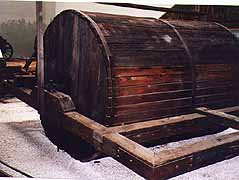
Snowroller
|
There was a reconstructed hotel, an area one-room schoolhouse,
even a 20th c. diner used until 1980 !! Also a “three sister”
garden outside showing the plants Native Americans always put
together (squash, corn and beans).
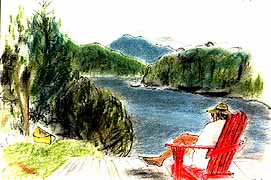
Labor Day at Goodnow (Peggy)
|
A great exhibit on mining in the Adirondacks and they showed you
what products were produced from each metal mined. Super diorama
of the whole operation - actual examples of pig iron, etc, for
you to touch, good pictures of miners.
A great boats exhibit etc etc. Great museum (for everyone?). |
(Memo #3)
|
Sept. 1 - Industrial Remains
A ghost town in a wilderness park
Topics: mining, why /when are parks established, photographers
as social activists.
WHO? industrialists, iron smelters, mine workers
WHAT? abandoned industrial sites
WHERE ? Ironville and Tahawus, New York (Adirondack Mountains)
WHEN? 18th century
HOW? mining and smelting |
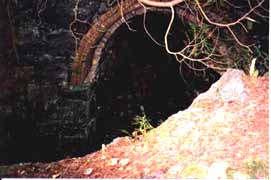
Old smelter
|
The image of the Adirondacks is blue sky and lakes, green forests
and mountains. Under it all apparently was/is tremendous mineral
wealth. In fact, it was the horrors of mining, and its impact
on the environment, that lead to the establishment of the Adirondacks
Park. So today I got the tour of the industrial Adirondacks.
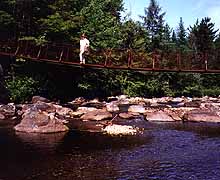
First Bridge over Hudson
(Larry Peterick Photo)
|
We went east almost to Lake Champlain to visit the small village
of Ironville. Today it is a small lovely village of white homes
surrounded by large trees. It was an iron smelting center. You
can see the bed where the railroad was that hauled it all in and
out. You can see incredible bits of walls and mounds. The fortune
made by the smelter lead to the departure of the first family
of Ironville for Boston, but they came back every summer. In their
house are many bits of the family history, from rocking horses
for the children to Civil War uniforms to the paymasters’ window
from the business. There is a display of a crude electromagnet
demonstrated first in the yard, which gives it the right to claim
electricity was first invented here!
A huge industrial fortune and all that remains are grass-covered
mounds. |
On we went to the ghost iron mining town of Tahawus, maybe ten
miles up a dead end road in the central Adirondacks. The Hudson
River rises near here and we stopped to walk down to it. It’s
a gentle stream about thirty feet wide, crossed by a suspension
bridge. My host noted that both the first and last bridges over
the Hudson are suspension. Further up the road you see the huge
slag hills stretching along the stream. They’re now covered with
some grass, but are still stark. The open pit iron mine is still
being used, and is roped off.
|
On we went to the ghost town. Houses along the Main Street quite
close to each other, some over the river on piles, you can see
houses and parts of houses up the slopes. The woods have crept
back and trees break the view in all directions. Vines cover walls,
roofs sag. Interestingly, the cedar poles supporting the houses
look perfect.
The main furnace is still to be seen. A huge stone and brick construction
that nature is reclaiming. The size and craftsmanship are extraordinary,
the bricks at the top of the furnace are carefully herringboned.
There is some talk of a national site, but the company currently
owning it doesn’t want to give it up.
|
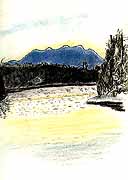
Goodnow Sunset
(Peggy)
|
Drive back up the road and you are in the Adirondacks, the only
cars belonging to hikers and fishermen. Hard to believe industrial
settlements were there.
9/1... Goodnow Flowage.
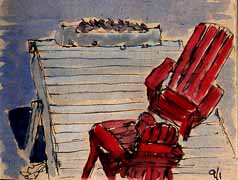
Goodnow Dock
(Bryce)
|
We’ve enjoyed a two-day hiatus from the historic road here in the Adirondacks. Not that we haven’t
soaked up some old tales. Peggy went over to Ironville to see
where mining began in these hills, and we visited the Adirondack
Museum which was full of guide boats, logging paraphernalia, and
resort memorabilia. But our time has been spent mostly enjoying
this idyllic lake and the generous hospitality of Barbara and
Larry (an aunt and uncle-in-law we should have known better years
ago). Swimming, mini-kayaking, doing watercolors and pastels of
the postcard views, smoozing and sunning. This afternoon we fired
up the sauna (a nifty barrel design 6 foot high and 8 foot long),
then hopped back and forth between the lake and the sauna. Ultimate
luxury. |
This spot, Goodnow Flowage was dammed by the loggers as an impoundment
lake to store logs for the spring drive down the Hudson. Eventually
the paper company owner sold off shorefront to an owners’ association,
and presto, instant community. No jet skis, highpower boats, or
general aggro. Huge cedar stumps memorializing the old woods poke
up along the shore, loons calling in the morning mist, and convivial
company. Who could ask for more? This basin of old hills in an
eroded plateau drains into a place apart from the hubbub of highways,
and the ruddy light of sunset warms the evening trees, and our
hearts.
|
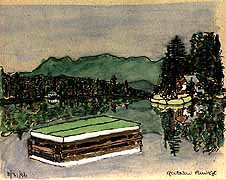
Mountain ease (Bryce)
|
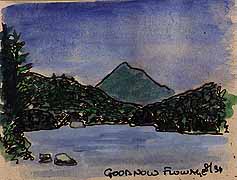
and Flowage (Bryce)
|
In order to get out to you listeners we motored the length of
the lake to use a neighbor’s phone jack, and computer expertise.
After a number of false starts, we succeeded in getting out of
the Flowage. Then we were treated to a face-to-face with a red-tail
hawk. These helpful neighbors do raptor rescue work, and they
had a wounded hawk in their big cage. Close-up this great bird
was stunning, in his proud plumage, and BIG. It was an honor to
be in the same space with him. Now we must fly. |









